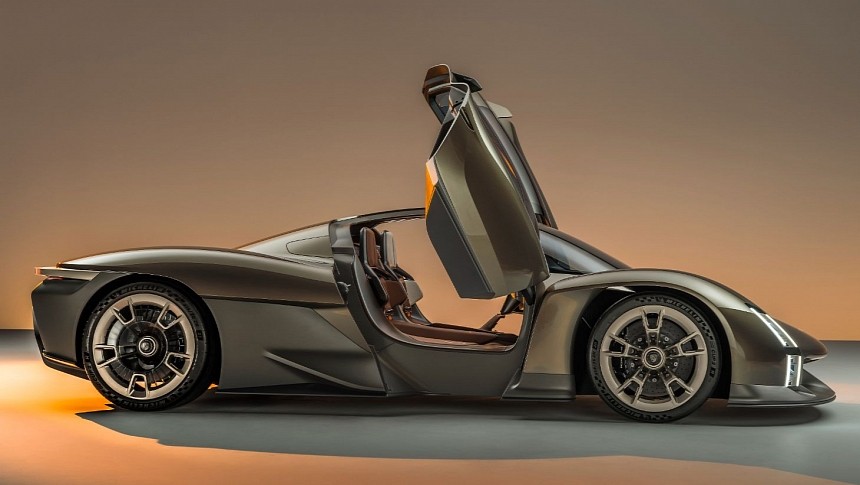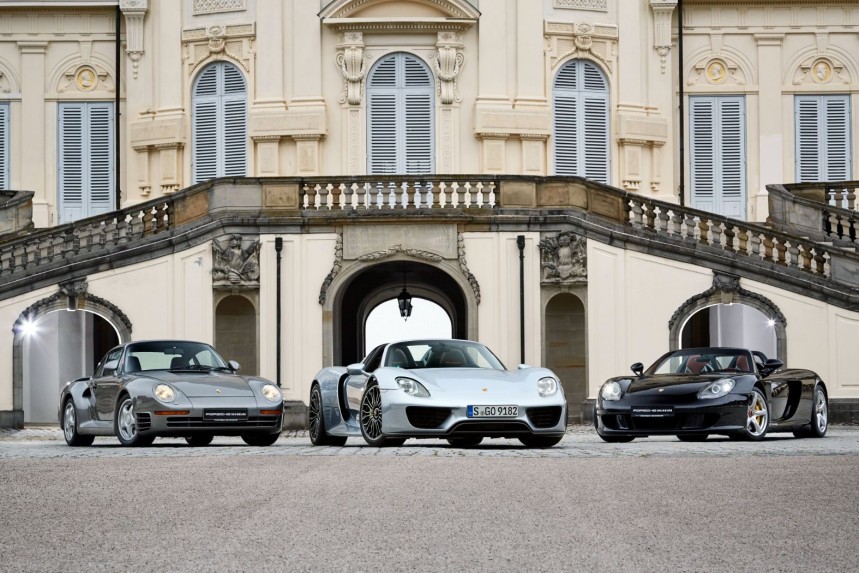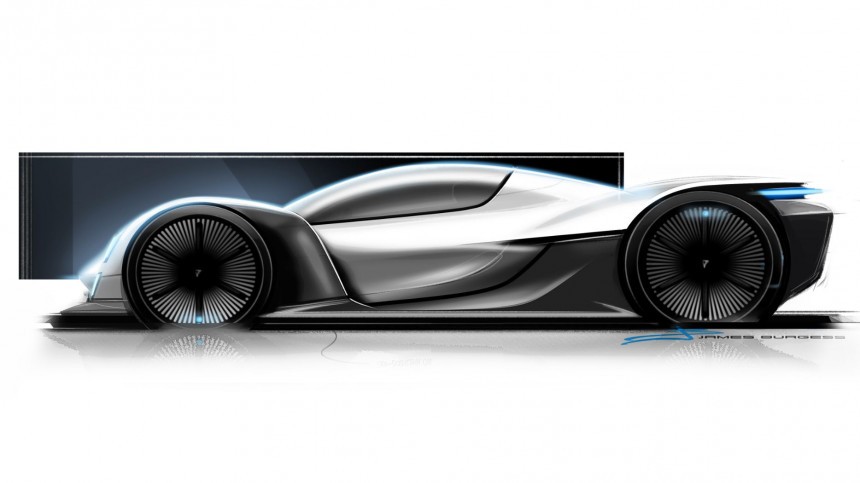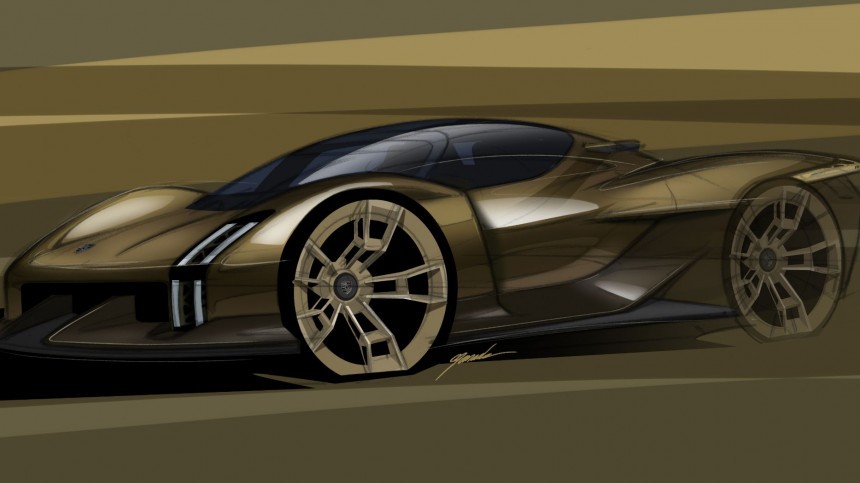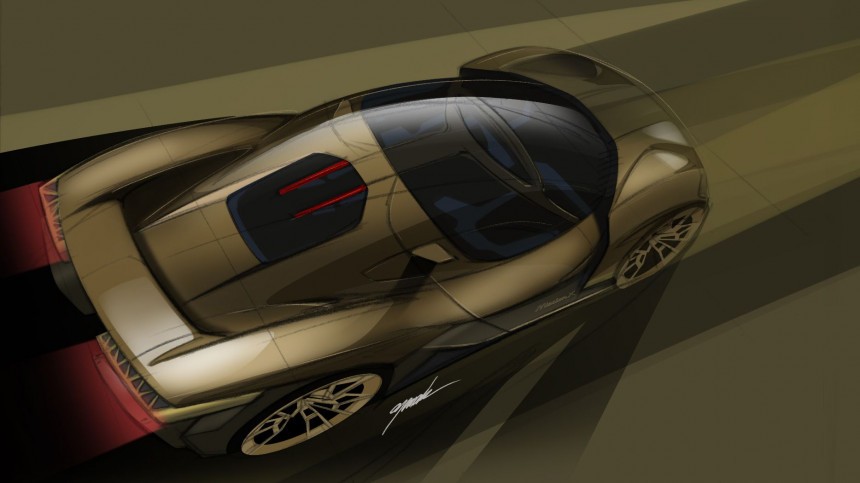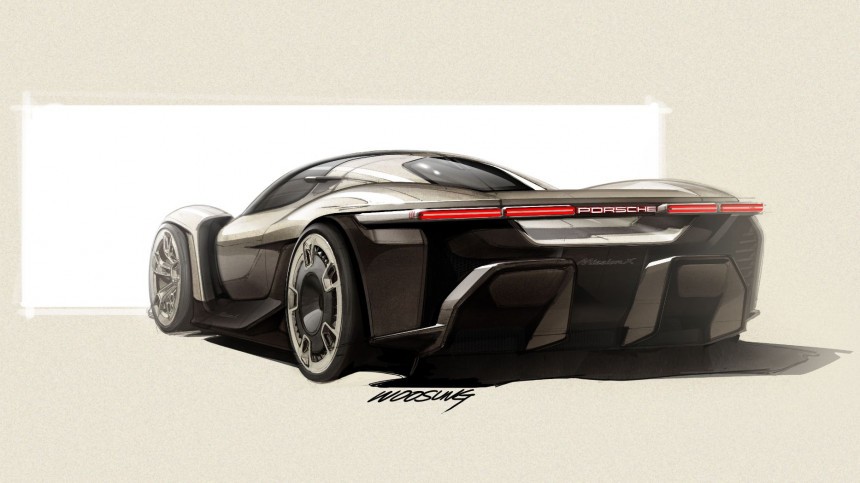One of the quickest and most successful racing cars of the first quarter of the 21st century, Porsche's 919 Hybrid won the legendary 24 Hours of Le Mans endurance race no less than three times in a row.
To honor that achievement, an 'Evo' version of the same car, built without bowing to racing regulations, managed to lap the Nurburgring Nordschleife in a mind-bending 5:19:55 minutes, quicker than any other road vehicle before it and establishing a new record.
Coincidentally, the previous all-time Nurburgring lap record had also been set by a Porsche almost 35 years earlier, with Stefan Bellof taking his 956 race car around the Nordschleife in a staggering 6:11.13 minutes during a qualifying run for an endurance race.
Why are these Nurburgring lap records essential to our discussion today, you ask? Well, Porsche currently needs two history-making events.
The first one is a hypercar in its lineup, with the last ultra-exotic vehicle to come out of Weissach being the 918 Spyder, unveiled over a decade ago.
The second one is the need for a road-car Nurburgring record, currently belonging to the F1-powered Mercedes-AMG One, which achieved 6:35.183 minutes on the full lap and in damp track conditions.
At the same time, the automotive industry is on the cusp of a revolution, with electric vehicles spearheading the charge toward a more sustainable future.
Porsche has been at the forefront of this transformation with the Taycan lineup and will continue to be with the next generations of the 718 Cayman and Boxster, Macan, and Cayenne, which will all be powered exclusively by electrons in less than a decade. As whispers and rumors swirl, it's becoming increasingly apparent that Porsche is ready to make a thunderous entrance into the electric hypercar segment.
While the 911 will remain the last bastion of internal combustion-engined Porsches, the sports carmaker is currently trying to hit two birds with one stone by developing a new all-electric hypercar that will also snatch the production-car Nurburgring lap record from the Mercedes-AMG One.
Its overall design and some of its technical features have already been previewed by the Mission X and other recent concepts. Still, you should expect Porsche to go a step further with the production version of the model.
The Porsche Mission X production version has some pretty big shoes to fill, continuing a lineage consisting of the 959, Carrera GT, and the 918 Spyder.
Powered by a twin-turbocharged flat-six, a wind-tunnel sculpted body, and an innovative all-wheel-drive system, the Porsche 959 had a top speed of 197 mph (317 kph), making it the fastest production car of the 1980s.
With a naturally aspirated V10 engine based on a stillborn Le Mans project and a manual transmission, the Carrera GT was a worthy successor to the 959 and Porsche's first road car made from carbon fiber.
Porsche's hypercar lineage culminated with the hybrid 918 Spyder, the first road-legal vehicle to crack the seven-minute lap time barrier on the Nurburgring in 2013.
These three ultimate exotics are the forefathers of whatever comes out of the Mission X, so you can bet Porsche is throwing its best technical resources at the project.
Like the Mission X concept car, the yet-unnamed electric hypercar will emulate many past Porsche endurance racing cars regarding design, including the legendary 956 and 962. This translates into tiny styling gimmicks, like the Le Mans-style door opening, the extra window above the windshield, or the bubble shape of the cockpit.
The overall look of the exterior already gives futuristic endurance racer vibes, but you can expect the production version to be even more polished.
With a minimalist design aesthetic, high-quality materials, and advanced connectivity, the Mission X's interior is a sanctuary where technology and refinement converge.
Haptic touch controls, augmented reality displays, and an intuitive but unembellished infotainment system will seamlessly integrate into the driving experience of the production model, providing only vital information to the driver.
Set to possess the DNA of a race car, the upcoming Porsche electric hypercar promises to push the boundaries of performance. This hypercar is poised to leave onlookers in awe with sleek aerodynamics, carbon fiber construction, and a design language that exudes elegance and aggression. But it's beneath the exquisite bodywork where the true magic unfolds.
It's odd mentioning 'endurance' when talking about an electric vehicle, but Porsche hopes its work in developing new batteries and weight management will give the upcoming e-hypercar a sufficient range, especially on the track.
Thanks to the carmaker's expertise in electric propulsion, the model is expected to feature an advanced electric drivetrain that delivers unprecedented performance. Combining at least two electric motors and cutting-edge battery technology should propel the beast to staggering speeds, ensuring mind-boggling acceleration and seamless power delivery.
Early whispers suggest that a range of over 500 miles (802 km) on a single charge may be within reach, primarily thanks to efficient aerodynamics, a 1/1 power-to-weight ratio, and a new way of integrating the battery.
Drawing inspiration from the Mission R Concept and the upcoming electric 718 Cayman and Boxster, the 900V battery will not sit underneath the floor but behind the two seats. This means that instead of being flat, it will be almost cube-shaped, bringing two almost insurmountable issues that Porsche engineers have already solved.
Firstly, its shape should come with some temperature problems, but it will probably use an innovative type of liquid cooling, not unlike what Mercedes-AMG has developed for its plug-in hybrids.
Secondly, the car should have a raised center of gravity compared to a regular EV based on a skateboard-like platform, but Porsche has chosen this route to recreate the driving feeling of a mid-engine car, where most of the weight is found right in the middle.
Its powertrain will likely be previewed in the upcoming Taycan Turbo GT, which will deliver around 1,000 HP (987 PS). Some insider voices say it will comprise three electric motors (one on the front axle and two on the rear), like the Tesla Model S Plaid, but two or four are also possible.
Expect the electric hypercar to go a big step further regarding power while dropping a lot of weight compared to the Taycan, though. Porsche has let it slip that the model will deliver a 1/1 power-to-weight ratio, so its powertrain is expected to provide at least 1,500 HP for a 1,500 kg (3,300 pounds) car, if not more.
This should give it a better power-to-weight ratio than the obnoxiously fast Rimac Nevera, the quickest accelerating (and braking) EV on the planet.
Harnessing all that power is likely the trickiest part, so the model will feature adaptive aerodynamics and an advanced torque vectoring system on top of an intelligent all-wheel-drive setup.
It would also generate more downforce at speed than the 911 (992) GT3 RS, which can create up to 1,895 pounds (860 kg) at 177 mph (285 kph), or more than 900 pounds (408 kg) at 124 mph (200 kph).
With an unwavering focus on dynamics, this hypercar should redefine the boundaries of what's possible in an electric vehicle. As with its predecessor, exclusivity is a given. Limited production numbers and meticulous attention to detail will ensure that owning a Porsche electric hypercar becomes an unparalleled experience.
The fortunate few who secure a spot behind the wheel will become custodians of a future legend, a testament to Porsche's relentless pursuit of automotive excellence.
Although shrouded in speculation, Porsche's foray into the electric hypercar realm based on the Mission X concept car promises to be a game-changer. Since the carmaker is currently busy building a business case for its production, don't expect its arrival before 2025.
The new model should set new benchmarks in the automotive world by combining cutting-edge technology, electrifying performance, and Porsche's unwavering commitment to driver engagement.
Coincidentally, the previous all-time Nurburgring lap record had also been set by a Porsche almost 35 years earlier, with Stefan Bellof taking his 956 race car around the Nordschleife in a staggering 6:11.13 minutes during a qualifying run for an endurance race.
Why are these Nurburgring lap records essential to our discussion today, you ask? Well, Porsche currently needs two history-making events.
The first one is a hypercar in its lineup, with the last ultra-exotic vehicle to come out of Weissach being the 918 Spyder, unveiled over a decade ago.
The second one is the need for a road-car Nurburgring record, currently belonging to the F1-powered Mercedes-AMG One, which achieved 6:35.183 minutes on the full lap and in damp track conditions.
At the same time, the automotive industry is on the cusp of a revolution, with electric vehicles spearheading the charge toward a more sustainable future.
Porsche has been at the forefront of this transformation with the Taycan lineup and will continue to be with the next generations of the 718 Cayman and Boxster, Macan, and Cayenne, which will all be powered exclusively by electrons in less than a decade. As whispers and rumors swirl, it's becoming increasingly apparent that Porsche is ready to make a thunderous entrance into the electric hypercar segment.
While the 911 will remain the last bastion of internal combustion-engined Porsches, the sports carmaker is currently trying to hit two birds with one stone by developing a new all-electric hypercar that will also snatch the production-car Nurburgring lap record from the Mercedes-AMG One.
Its overall design and some of its technical features have already been previewed by the Mission X and other recent concepts. Still, you should expect Porsche to go a step further with the production version of the model.
Passing the baton
Powered by a twin-turbocharged flat-six, a wind-tunnel sculpted body, and an innovative all-wheel-drive system, the Porsche 959 had a top speed of 197 mph (317 kph), making it the fastest production car of the 1980s.
With a naturally aspirated V10 engine based on a stillborn Le Mans project and a manual transmission, the Carrera GT was a worthy successor to the 959 and Porsche's first road car made from carbon fiber.
Porsche's hypercar lineage culminated with the hybrid 918 Spyder, the first road-legal vehicle to crack the seven-minute lap time barrier on the Nurburgring in 2013.
These three ultimate exotics are the forefathers of whatever comes out of the Mission X, so you can bet Porsche is throwing its best technical resources at the project.
Inspiration
The overall look of the exterior already gives futuristic endurance racer vibes, but you can expect the production version to be even more polished.
With a minimalist design aesthetic, high-quality materials, and advanced connectivity, the Mission X's interior is a sanctuary where technology and refinement converge.
Haptic touch controls, augmented reality displays, and an intuitive but unembellished infotainment system will seamlessly integrate into the driving experience of the production model, providing only vital information to the driver.
Technical Prowess
It's odd mentioning 'endurance' when talking about an electric vehicle, but Porsche hopes its work in developing new batteries and weight management will give the upcoming e-hypercar a sufficient range, especially on the track.
Thanks to the carmaker's expertise in electric propulsion, the model is expected to feature an advanced electric drivetrain that delivers unprecedented performance. Combining at least two electric motors and cutting-edge battery technology should propel the beast to staggering speeds, ensuring mind-boggling acceleration and seamless power delivery.
Early whispers suggest that a range of over 500 miles (802 km) on a single charge may be within reach, primarily thanks to efficient aerodynamics, a 1/1 power-to-weight ratio, and a new way of integrating the battery.
Drawing inspiration from the Mission R Concept and the upcoming electric 718 Cayman and Boxster, the 900V battery will not sit underneath the floor but behind the two seats. This means that instead of being flat, it will be almost cube-shaped, bringing two almost insurmountable issues that Porsche engineers have already solved.
Firstly, its shape should come with some temperature problems, but it will probably use an innovative type of liquid cooling, not unlike what Mercedes-AMG has developed for its plug-in hybrids.
Secondly, the car should have a raised center of gravity compared to a regular EV based on a skateboard-like platform, but Porsche has chosen this route to recreate the driving feeling of a mid-engine car, where most of the weight is found right in the middle.
Two, Three, or Four Electric Motors?
Expect the electric hypercar to go a big step further regarding power while dropping a lot of weight compared to the Taycan, though. Porsche has let it slip that the model will deliver a 1/1 power-to-weight ratio, so its powertrain is expected to provide at least 1,500 HP for a 1,500 kg (3,300 pounds) car, if not more.
This should give it a better power-to-weight ratio than the obnoxiously fast Rimac Nevera, the quickest accelerating (and braking) EV on the planet.
Harnessing all that power is likely the trickiest part, so the model will feature adaptive aerodynamics and an advanced torque vectoring system on top of an intelligent all-wheel-drive setup.
It would also generate more downforce at speed than the 911 (992) GT3 RS, which can create up to 1,895 pounds (860 kg) at 177 mph (285 kph), or more than 900 pounds (408 kg) at 124 mph (200 kph).
Epilogue
The fortunate few who secure a spot behind the wheel will become custodians of a future legend, a testament to Porsche's relentless pursuit of automotive excellence.
Although shrouded in speculation, Porsche's foray into the electric hypercar realm based on the Mission X concept car promises to be a game-changer. Since the carmaker is currently busy building a business case for its production, don't expect its arrival before 2025.
The new model should set new benchmarks in the automotive world by combining cutting-edge technology, electrifying performance, and Porsche's unwavering commitment to driver engagement.
